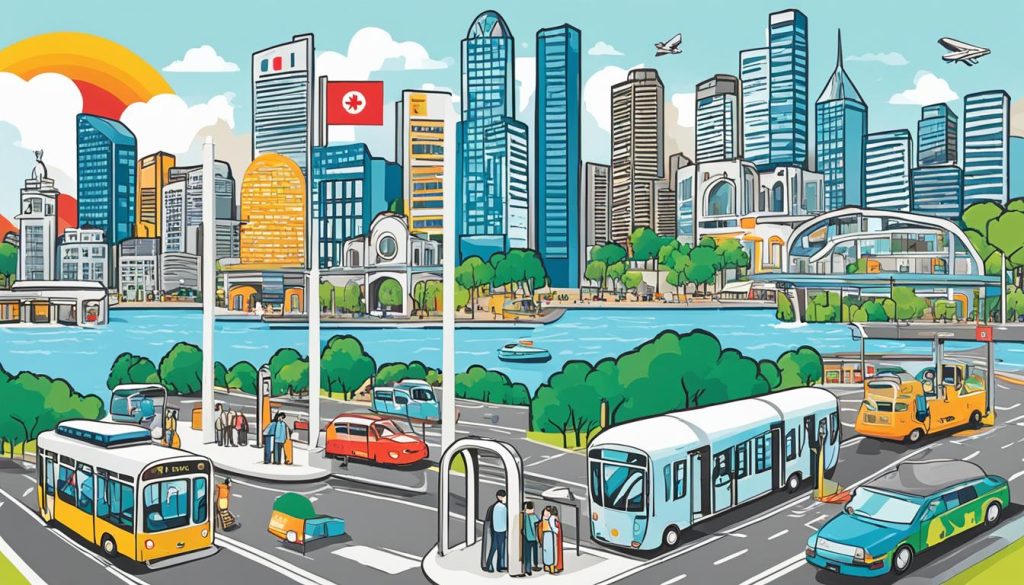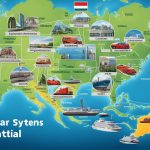When we compare cost of living, economic stability, and quality of life, we get a clear picture of life in different countries. Singapore, Canada, and New Zealand stand out. They show us how economies, societies, and policies mix together. Each country has its way of managing public healthcare, how much people can buy, and what living there feels like, thanks to how many people live in each area.
Looking at GDP per capita, how much is spent on education, and how people live day-to-day gives us insight. This deep dive helps us see what makes each country special. Let’s explore together the details that shape everyday life and the wider economic and social picture.
Economic Overview: A Comparative Analysis
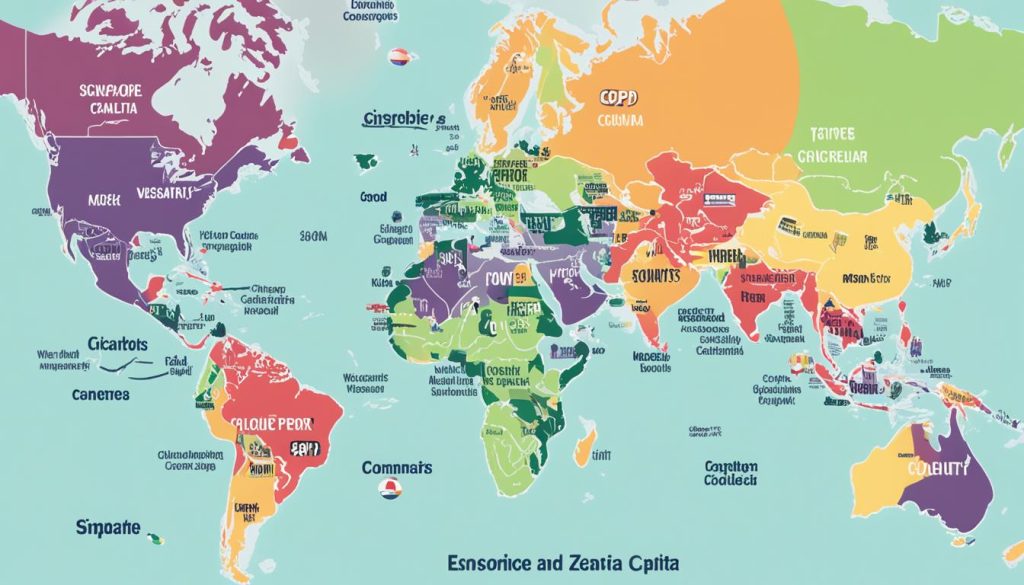
When we look closely at the economies, each country – Singapore, Canada, and New Zealand – shows us different levels of wealth and ability to buy goods. GDP per capita uncovers these contrasts vividly. Each has its own economic story, influenced by how they manage money, debt, and their economic results lately.
GDP Per Capita Contrast
Singapore’s GDP per capita is truly remarkable, showing its powerful economy and the wealth each person can potentially have. With a GDP of $106,000, it’s a lot higher than New Zealand’s $40,266 and Canada’s. This gap highlights not just Singapore’s wealth but also its high standard of living and purchasing power.
Public Debt and Economic Stability
New Zealand demonstrates smart money handling with a public debt ratio at 31.7% of its GDP. Meanwhile, Singapore’s debt ratio of 111.1% might raise eyebrows. Yet, it still keeps its economy stable. This shows trust in its economic policies and future growth.
Real GDP Growth Rate: A Significant Economic Indicator
The GDP growth rate tells us about an economy’s energy. Singapore excels with a 7.61% growth rate, much higher than New Zealand’s 3%. This sets Singapore apart as a fast-growing economic scene, unlike the steadier pace seen in its peers.
Looking at the overall financial health, each country brings something unique to the table. Singapore is ahead in growth and income per person, while New Zealand scores on managed finances and stability. These differences give us a deeper understanding of how each country achieves economic stability and prosperity.
The Cost of Living: Expenses in Perspective
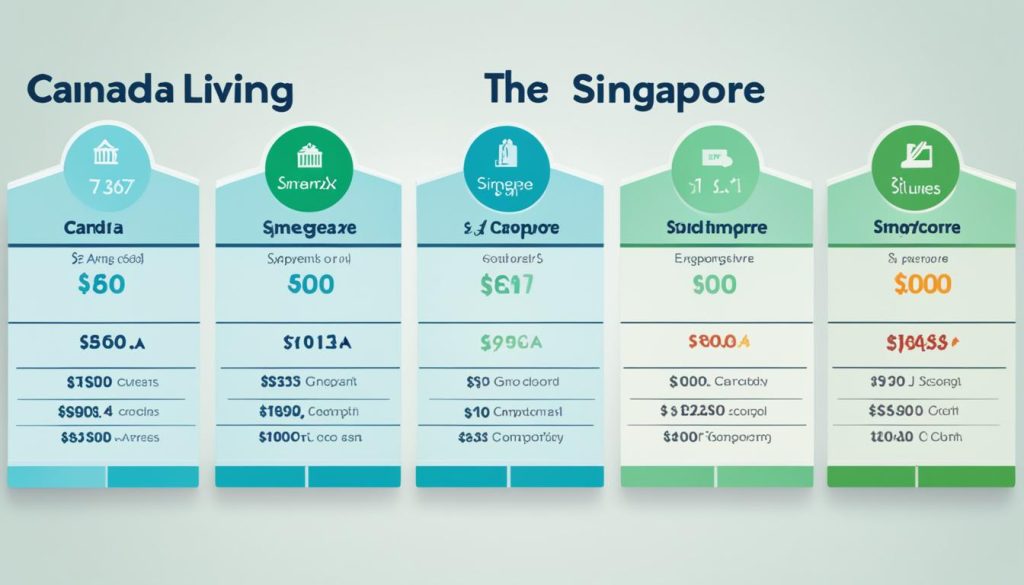
Exploring the cost of living, daily costs, and housing prices offers insight into the income needed for a good life in Singapore, Canada, and New Zealand. The cost of living index shows the expense needed to maintain a lifestyle in different places.
Daily costs include food, transport, and utilities prices. These significantly affect how much money goes out each month. Each country has its own economic settings, making the standard of living costs vary widely.
Housing prices play a key role in the cost of living index. It’s important to see how average earnings match up with home prices or rents in these nations. Affordable homes mean more money for other needs, leading to a better life quality.
- Adding up these costs shows what people and families need to budget for.
- The difference in prices for goods and services shows the economic challenges in these countries.
- A high cost of living index often means homes are less affordable, requiring higher incomes for a similar lifestyle.
This view helps us see how each country compares in economic strain and chances for a comfortable life with savings. It’s vital for those looking to move or understand these nations’ economies.
Societal Well-being: Deconstructing the Quality of Life Index

Looking at how happy societies are goes beyond just money. We look at many elements that add up to being truly satisfied with life. The World Happiness Report and the Corruption Perceptions Index shine a light on this. They show us how happy people are in their countries and how much they trust their governments.
World Happiness Report Rankings
This index digs into how people feel about their well-being in places like Singapore, Canada, and New Zealand. It weighs many things, like how rich a country is, how much support people have from friends and family, and how free they feel. These countries score well, showing us what makes people happy.
Corruption Perceptions: Clean vs. Tainted Governance
Trust in the government is key to a happy society. Dirty politics can ruin that trust. That’s where the Corruption Perceptions Index comes in. It tells us how clean or corrupt countries like Singapore, Canada, and New Zealand are seen. This affects how satisfied people are with their lives.
- Exploration of subjective well-being as part of the happiness index
- Examination of life conditions contributing to societal contentment
- Analysis of government integrity through the Corruption Perceptions Index
- Assessing the impact of public trust on life satisfaction
Educational Advantages: An Investment in the Future

When we think about a nation’s future, the focus on educational outcomes and investment in education is key. Quality education is essential for sustainable growth. It helps build a society ready to face future challenges. Looking at New Zealand and Singapore shows us how each country values education.
School Life Expectancy and Literacy Rates
The link between education and society’s growth is clear with school expectancy and literacy rate. School expectancy is particularly important. New Zealand has a school life expectancy of 19 years, which is more than Singapore’s 16 years. These numbers show how long education lasts and its quality in these countries.
A high literacy rate means better educational outcomes. Exact numbers are scarce, but both countries aim for a literate and skilled population. This goal underlines reading and writing as key parts of education. It shows how literacy drives economic and social progress worldwide.
Education Expenditures by Country
A country’s investment in education shows how much they care about future generations. Looking at finances, New Zealand spends about 6.3% of its GDP on education. Singapore spends 2.9%. This difference highlights how each country values their educational system and its impact on public spending on schools.
As economies move towards knowledge-based systems, understanding educational investments is crucial. Seeing how New Zealand and Singapore invest differently gives us insights into their goals. New Zealand is investing more now for a richer educational future.
Healthcare Systems: Evaluating Public and Private Sectors

The world of healthcare has many dimensions. The balance between public healthcare and private facilities is key to making healthcare available and affordable. Every country needs to ensure they have enough medical resources. It’s not only about having a lot of these resources. It’s about how they are used and how they affect public health.
Hospital Beds and Healthcare Infrastructure
The number of hospital beds per person is a way to see if a country can deliver good healthcare. For example, New Zealand has 2.8 beds for every 1,000 people. This is slightly better than Singapore. This small difference highlights the varied strengths of healthcare systems. It also shows where there is room to improve.
Has Public Healthcare? A Comparative Insight
In looking at healthcare, the difference between public and private sectors is important. New Zealand guarantees public healthcare for all, making medical care affordable and accessible. On the other hand, Singapore does not guarantee public healthcare. This creates a unique challenge. Both sectors must work together to offer quality and accessible medical services. This comparison makes it clear how public healthcare deeply affects a society’s health and well-being.
- Whether a country has universal public healthcare or a privatised system affects how easy it is to get healthcare.
- How affordable treatment is depends heavily on the type of healthcare system a country has — public or private.
- Putting money into hospital infrastructure is crucial for improving healthcare services in any country.
In this section, we explore the core of healthcare systems. We aim to teach readers about different approaches to healthcare. This helps us understand how medical infrastructure and policies affect the health of society. It also shows the financial impact on individuals.
Environmental Benchmarking: Green Spaces and Pollution

The importance of environmental health is now more understood. It’s vital for the well-being of societies. To see how countries manage their environment, we look at their green spaces and pollution levels. Canada is known for its large wilderness and has lots of forests and farms. These places offer peace in the beauty of nature. On the other hand, Singapore, being a city-state, has to fit green areas into its urban space. This requires creative ideas in sustainability and planning.
- Green Spaces: New Zealand is great at providing green areas with its national parks, protected lands, and community gardens. These places greatly improve the country’s environmental health.
- Pollution Control: Canada’s efforts to keep pollution low are impressive. This helps protect its vast wildlife and natural areas.
- Urban Integration: Singapore works hard to blend sustainable practices with city development. It has vertical gardens and green buildings, which is tough with many people living close together.
The topic of green spaces versus pollution in countries like Singapore, Canada, and New Zealand shows their different approaches but shared goal. Keeping our environment healthy is something we all must work towards. It’s a global duty that requires new ideas and actions for sustainable living.
To sum up, every country has its unique way of including nature. But all agree on the need to look after our planet’s environmental health. We must work to grow green spaces and reduce pollution levels. This way, we can give a healthier, more balanced Earth to the next generations.
Income Equality and Employment: A Look at the Gini Index and Job Markets
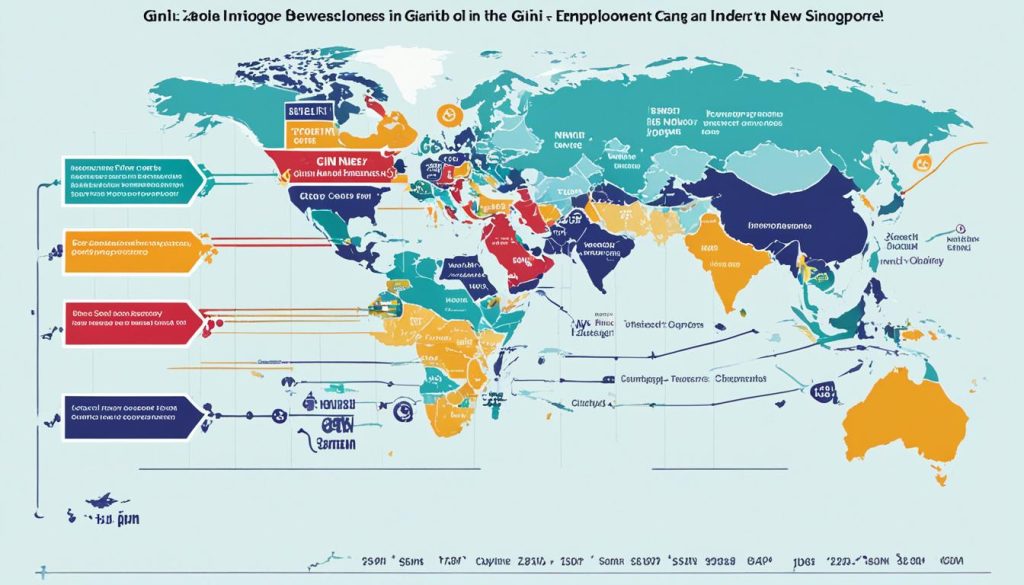
When we look at an economy’s strength, we focus on job chances and how wealth is spread. The Gini Index helps us see how money is shared out, highlighting the wealth gap. It spotlights if the rich and the poor are too far apart. Job rates also matter, showing if people can find and keep work. These signs together tell us if a country’s job scene is strong and fair.
Unemployment Rates: Seeking Security in Employment
Singapore’s low unemployment rate of 2.2% shows it has lots of jobs, giving people financial peace of mind. On the other hand, New Zealand’s unemployment rate of 4.7% suggests less job security. However, there are still many chances to find work there.
Inflation Rate: Monitoring Currency Health
Inflation changes how much things cost and affects a country’s economic mood. Singapore’s inflation rate at 6.1% stands out compared to New Zealand’s 7.2%. This suggests Singapore is better at keeping price rises in check. By doing so, it helps its people’s money go further. Managing inflation well lets everyone feel more financially secure and stable.
Demography and Population Dynamics

When we look at Singapore, Canada, and New Zealand, the differences in people’s lives are striking. Urbanisation changes how societies look and feel. In these countries, it shows in varied ways, from crowded cities to vast, open spaces. Singapore’s busy city life contrasts sharply with New Zealand’s wide-open landscapes. This shows how environments shape people’s daily experiences and relationships.
Population Density: Urban Bustle vs. Spatial Solitude
Singapore and New Zealand are worlds apart in how packed they are. Singapore’s crowded streets are filled with 7804 people per square kilometer. This shapes a lively, close-knit community in a city that never sleeps. Meanwhile, New Zealand’s 18 people per square kilometre make for a calm, spacious way of living. This offers peace and a deep connection with the natural world around them.
Gender Demographics and Life Expectancy
Looking deeper, we see how each country’s mix of men and women and their life spans tell us about their health and society. Singapore shines with high life expectancy, showing its world-class healthcare. It points to the nation’s focus on good health and medical care. These countries’ gender mixes hint at different social challenges and possibilities for growth.
Understanding these demographic details helps us see how each country is unique. From how people live to how long they live, from urban jungles to gender ratios, these aspects guide us to a fuller understanding and respect for each country’s story.
Legal and Civil Framework: Assessing Rights and Freedoms
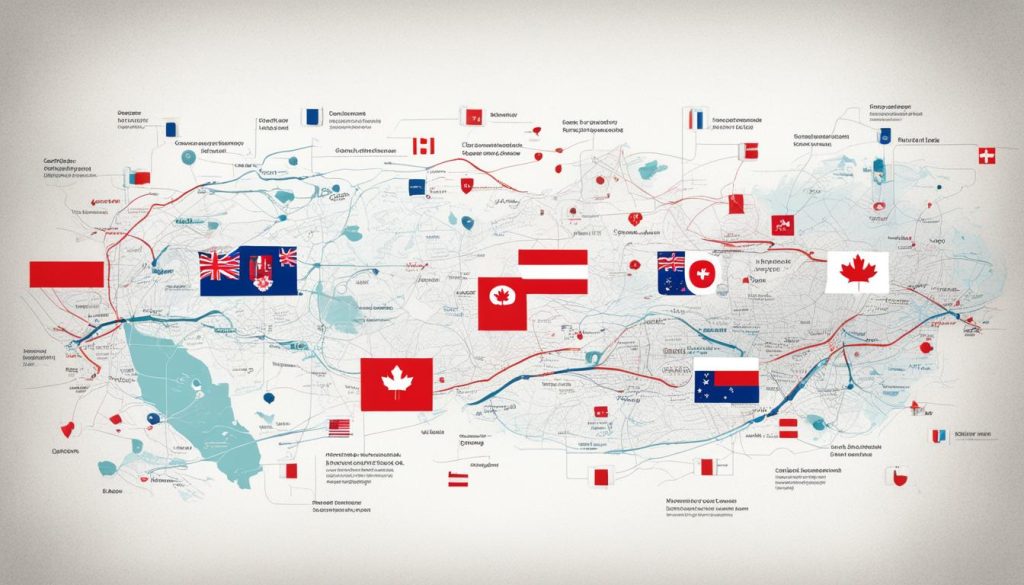
The legal systems in Singapore, Canada, and New Zealand support a strong community. They ensure citizens know their rights and can take part in democracy. Rule of law is key, making sure laws are fair and justice is blind.
When we look at government regulation quality, these countries show they value governance. They focus on protecting freedoms and being open and accountable. This shapes how people see their commitment to fairness, both at home and abroad.
Democratic participation is also vital in these legal and civil settings. It lets people have a say in politics. This is crucial for making sure the public’s views influence decisions.
- The extent to which the rule of law is respected across different levels of governance and society.
- The effectiveness and efficiency of government regulations in maintaining societal order while promoting freedoms.
- The avenues available for citizens to engage in democratic processes and contribute to policy formulation.
Looking at these three nations shows differences in managing government rules and freedoms. But, the rule of law is always the foundation of their legal systems. It proves their dedication to fair and democratic societies.
Evaluating Consumer Power: Local Purchasing Ability and Retail Landscape
In these changing economic times, the cost of dining out and groceries greatly affects a country’s purchasing power. By looking at spending habits, we can understand how much people are involved in the retail sectors of places like Singapore, Canada, and New Zealand. The decisions consumers make show us the balance between their income and the living costs they face.
Restaurants and Groceries Indices
Indices tracking costs for eating out and buying groceries give us deep insights. They tell us about what people choose to eat and the variety of the food market. They also highlight how people manage their money against the dining options they have. Whether buying a meal on the go or shopping for the week, these indices show how people handle their daily costs and budgeting habits.
Consumer Purchasing Trends: Insights into Local Buying Power
Looking into how people spend their money gives us a better picture of their role in the economy. It shows us not just what they buy, but how their buying power influences their choices. By examining spending across various sectors, from needs to wants, we see how spending links to a country’s economic health. This study makes clear how folks in Singapore, Canada, and New Zealand cope with their financial situations.
- Review of meal and supermarket expenditure as a measure of affordability of dining and living.
- Analysis of grocery pricing and its impact on household financial planning.
- Examination of consumer choices in the context of a country’s price index.
- Assessment of the factors influencing spending trends on basic and non-essential goods.
- Comparative study of economic participation through retail and service industry metrics.
Safety and Security: Feeling Secure in Cityscapes
Understanding safety in cities is vital. It helps create places where people can thrive. Crime rates and law enforcement are key in this. They help us know if a city is truly peaceful or not.
Crime Rates and Public Safety Metrics
Looking at crime numbers helps us gauge a city’s security. These stats show how common crimes are and influence our feelings of safety. Law enforcement’s role in reducing these crimes is crucial. Their visible presence helps prevent crime and makes people feel safer.
Improving strategies, like community policing, is important. It helps build trust between the police and the community. This trust leads to safer and more peaceful living spaces for everyone.
Peacefulness: Living without the Fear of Crime
Being free from the fear of crime matters a lot. The Global Peace Index measures this, looking at how safe societies are. Countries aim to score well by promoting peace and safety.
Investing in peace and safety helps everyone. It’s key for our well-being and for society to work together smoothly.
Climate Comparisons: Weathering the Seasons in Different Hemispheres
The climate is key when moving or investing abroad. It affects our lifestyle and daily activities greatly. Countries like Singapore, Canada, and New Zealand have different climates due to their hemispheric locations. This results in varied weather patterns and temperatures. Let’s explore how these geographic differences influence life and leisure in these places.
Singapore experiences steady temperatures year-round, thanks to its equatorial climate. The average temperature is around 27°C. This stable weather means people don’t have to change their lifestyles with the seasons. In contrast, Canada’s weather changes a lot, from very cold winters to hot summers. People there need to adapt to temperatures that can swing from below freezing to above 30°C. New Zealand, with its temperate climate, offers mild temperatures and moderate rain. It’s perfect for those who dislike extreme weather.
It’s important to understand these climate differences. They affect where we might want to live, our hobbies, and our work. Singapore’s warm climate is great for enjoying life indoors and outdoors all year. Canada offers seasonal activities, like skiing in winter and hiking in summer, for those who love an adventure. New Zealand’s steady climate is great for farming and tourism. So, weather patterns do more than just tell us what clothes to wear. They shape our lifestyles, leisure activities, and work in each country.

